Radiation state of the exclusion zone of 2023 in accordance with the results of radiation environmental monitoring
State Specialized Enterprise «Ecocentre»
https://orcid.org/0000-0001-7059-3655
Тetiana Nikitina
State Specialized Enterprise «Ecocentre»
https://orcid.org/0009-0003-6940-0686
Dmytro Samoilov
State Specialized Enterprise «Ecocentre»
https://orcid.org/0009-0000-0465-4077
Olena Buntova
State Specialized Enterprise «Ecocentre»
https://orcid.org/0009-0001-2060-3613
Oleksandr Fedorenko
State Specialized Enterprise «Ecocentre»
https://orcid.org/0009-0006-1387-709X
Tetiana Pylypchuk
State Specialized Enterprise «Ecocentre»
https://orcid.org/0009-0008-6908-0420
Vatslav Liaskivskyi
State Specialized Enterprise «Ecocentre»
https://orcid.org/0009-0000-7908-5809
Abstract
References
1. Annenkov, B.N., Yudyntseva, E.V. (1991). Fundamentals of agricultural radiology. Moscow, 43-92.
2. Chernobyl disaster and groundwater. (2002). Editor V. Shestopalov. Publisher Lisse/Abingdon/Exton(pa)/Tokyo. A.A. Balkema.
3. Environmental impact assessment of the Drawdown of the Chernobyl NPP Cooling Pond as a Basis for its decommissioning and remediation. (2019). IAEA-TECDOC-1886, IAEA, Vienna, 175.
4. Kanivets, V., Laptev, G., Konoplev, A., Lisovyi, H., Derkach, G., Voitsekhovych, O. (2020). Dynamics of Radionuclides in the Chernobyl Cooling Pond. In: Konoplev, A., Kato, K., Kalmykov, S. (Eds). Behaviour of Radionuclides in the Environment II: Chernobyl. Tokyo: Springer, 349–405. https://doi.org/10.1007/978-981-15-3568-0_8
5. Radiohydrogeochemistry of catchment basins of the Chernobyl Exclusion Zone. (2023). Under the editorship Shevchenko, O.L., Dolin, V.V. Kyiv: Naukova dumka, Ukraine. http://doi.org/10.15407/978-966-00-1855-6
6. Regional report on the state of the natural environment of the Kyiv region in 2021 (2022). Department of Ecology and Natural Resources of the Kyiv Region. Kyiv, Ukraine. https://mepr.gov.ua/wp-content/uploads/2023/04/Regionalna-dopovid-Kyyivskoyi-oblasti-u-2021-rotsi.pdf
7. Regulations on the state environmental monitoring system. (1998). Resolution of the Cabinet of Ministers of Ukraine dated March 30, 1998 # 391.
8. Report on the state of nuclear and radiation safety in Ukraine in 2022. (2023). State Inspection of Nuclear Regulation of Ukraine. https://snriu.gov.ua/storage/app/sites/1/%202022.pdf
9. Twenty-five years of the Chernobyl disaster. (2011). Security of the future. National report of Ukraine. Editors: Baloga, V.I., Kholosha, V.I., Yevdin, A.N. etc., Kyiv, Ukraine.
10. Voitsekhovych, O.V., Shestopalov, V.M., Skalskyi, A.S., Kanyvets, V.V. (2001). Monitoring of radioactive contamination of surface and underground waters after the Chernobyl accident. Kyiv.

